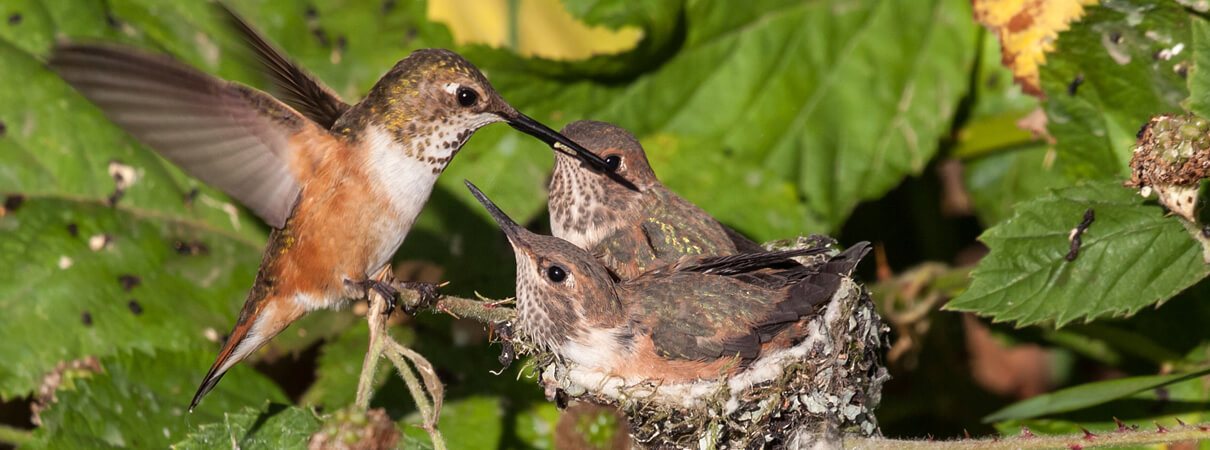
Rufous Hummingbird range map by Birds of the World, https://birdsoftheworld.org, maintained by the Cornell Lab of Ornithology.
At a tad over three inches long, the feisty red-and-orange Rufous Hummingbird is a tiny warrior, readily attacking birds many times its size, as well as large insects or anything else it perceives as a threat to its territory. It dominates feeders and choice flower patches, chasing away other hummingbird species such as the Calliope Hummingbird.
The Rufous Hummingbird is a standout in a family of already incredible American birds, and not only because of its moxie. It's also known for its stunning migration, one of the longest of any bird its size.
Incredible Journeys
The Rufous Hummingbird is the most northerly breeding member of the family Trochilidae. It nests from Oregon and Idaho north through much of British Columbia and into southern Alaska.
Traveling up to 3,000 miles to wintering grounds in western Mexican pine/oak and oak habitats, Rufous Hummingbirds can be found with other migrants such as the Western Tanager and Townsend's Warbler.
In recent years, the Rufous Hummingbird has been seen more regularly in winter in the southeast U.S., where it was once a rare stray. Sightings have piled up particularly along the Gulf Coast. This change is likely due to a warming climate, combined with an increase in suburban garden habitats and hummingbird feeders.
A Marvelous Memory
Research has revealed that the area of a hummingbird's brain related to learning and spatial memory — the hippocampus — is proportionately the largest of any bird group studied to date, occupying a percentage of “brain volume” up to five times larger than that found in songbirds, for example.
With enhanced spatial memory, the Rufous and other hummingbirds pinpoint prime locations of nectar, their main food source, and keep track of which blooms are at peak, visiting only when the flower provides its richest nectar supply. Remarkably, hummingbirds can also remember feeder locations from previous years, both on their home territories and along their migratory pathways.
Like all in its family, from the Esmeraldas Woodstar to the Blue-throated Hillstar, the Rufous Hummingbird needs a lot of fuel to sustain its nonstop daily activity. To keep its “tank” full, it must feed almost continuously throughout the day in short spurts of less than a minute at a time, often visiting more than 1,000 flowers in a day. But in addition to nectar, Rufous and other hummingbirds also need protein, both for themselves and for their fast-growing young. They get this nutritional mainstay from tiny insects and spiders that they capture in the air and on foliage and flowers.
Dashing Displays
Like other hummingbirds, including the Ruby-throated, male Rufous Hummingbirds court females with elaborate flight displays, including steep, U-shaped dives. During these flights, air rushing through the wings and tail produces a variety of buzzy, chattering noises that enhance the performance.
Listen to a male's display flight here:
(Audio of male Rufous Hummingbird's display flight by Andrew Spencer, XC76412. Accessible at www.xeno-canto.org/76412)
As with other hummingbird species, the male Rufous defends a breeding territory, which may contain several nesting females. After mating, the female does all the work of nesting and raising the young.

Female Rufous Hummingbird feeding young. Photo by Feng Yu, Shutterstock
Diminishing Returns
Although the species is still considered common, the Rufous Hummingbird's population is declining due to habitat loss on both breeding and wintering grounds, as well as threats along the long migratory route. These minuscule birds regularly fall prey to outdoor cats and other predators, while others die after window collisions.
ABC has a number of initiatives in place to tackle these dangers, including our Cats Indoors program, which encourages pet owners to keep cats and birds safe, and our Glass Collisions program, which offers solutions to keep birds from hitting windows.
The Rufous Hummingbird is a priority species for our Western program, including our work with the Sustainable Forestry Initiative. It's also benefiting from ABC's BirdScapes approach to migratory bird conservation, which focuses on the conservation of geographically linked habitats, both north and south.
Donate to support ABC's conservation mission and have your gift matched 1:1 now!



















































